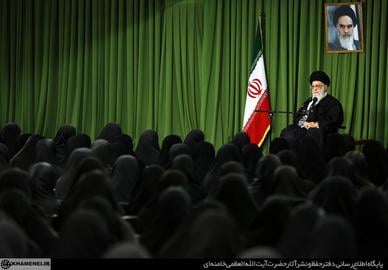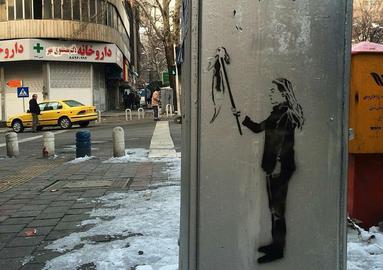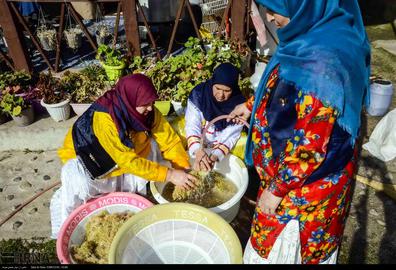Iran’s Supreme Leader marked International Women’s Day by dismissing the Revolution Women protest movement as “insignificant and small,” adding that the only achievement Iran’s “enemies” could claim was that “a few girls” had been "deceived into removing their scarves in a corner.” He also voiced strong support for police action in dealing with the matter.
The series of demonstrations, which began in late December, has seen lone women going out into public spaces to protest against the country’s law on the mandatory hijab, and has attracted huge international support and media attention.
Although Ayatollah Khamenei did not explicitly mention the Revolution Women movement, his speech on Thursday March 8 — backed up by tweets posted by his office — was a clear reference to the protests.
On March 7, news emerged that the first of the Revolution Women protesters had gone on trial, and had been sentenced to two years in prison. Many other protesters have been arrested in recent weeks, and await trial.
Khamenei said the protests, in which women stand on makeshift platforms, waving white or colored scarves on sticks to protest against forced hijab, were “the result of a vast and astronomically expensive propaganda campaign by the enemies to adversely influence the question of hijab.”
He also implicitly put his seal of approval on police action against such protests. “Whatever has been banned by sharia cannot be done in public,” he said, “because the government is duty-bound by Islamic sharia to prevent forbidden actions in public.”
A Warning to “Elites”
Khamenei also admonished what he described as the “elite group” who use the phrase “compulsory hijab." He implied that those who used the term, “journalists, intellectuals and clerics” among them, were helping the enemy achieve its goal, a goal it couldn’t achieve its own, despite all the investments it had made in trying. "A number of the people — hopefully unknowingly — follow the same path of the enemies,” he said. He rejected any claim that Ayatollah Khomeini, the founder of the Islamic Republic, had ever provided an escape clause for women who do not want to wear hijab. “They say that ‘Imam Khomeini’s directive that ‘women wear hijab’ did not refer to all women.’ Nonsense! I was present at the time. I know the reality. Imam Khomeini stood like a mountain against a clear repudiation [of sharia], promoted by Pahlavi [kings] and their successors.”
One of the “elites” that Khamenei was referring to is the cleric Mohammad Ali Ayazi, a seminary and university professor and a Koran scholar who is well known for opposing compulsory hijab. In an interview on February 26 [Persian link], he quoted Morteza Motahari, a close associate of Ayatollah Khomeini and an ideologue of the Islamic Republic who was assassinated by an extremist Islamic group just months after the revolution, in May 1979. According to Ayazi, Motahari had asked Khomeini about mandatory hijab and Khomeini had replied: “I don’t agree with it but they put so much pressure on me that I said hijab must be observed in [government] offices.” Ayazi added that based on this quotation, the hijab rule does not necessarily apply to the streets.
The Supreme Leader rejected the idea of hijab as a matter of choice. “The logic that says let the people choose themselves can also be used for other wrongdoings, like selling alcohol,” said Khamenei. “This can also be said for all other big social crimes. Is this a sensible ideology?”
On Twitter, Khamenei made his opinions on the western view of gender equality clear. “The western model for women is symbolic of consumerism, cosmetics, showing off for men as a tool of male sexual arousal,” he tweeted. “All they claim, including gender injustice and so on, is just talk. The reality is different.”
No Place for Discussion
This, of course, is not the first time that Khamenei has rejected the idea of the Islamic headscarf being a matter of choice. “There are misplaced discussions, like whether hijab is mandatory or optional,” he said on May 9, 2016. “There is no place for such discussions in the Islamic Republic.” As with his recent statements, he made a link between defying the law on hijab and other forbidden activities. “You cannot say that we should allow the sale of alcoholic beverages and then tell people not to drink it!”, he said. “It is not enough to say ‘don’t!’”
At the time, some principlist figures, including the cleric and university professor Mohammad Reza Zaeri, argued that hijab must be a matter of choice. However, when Zaeri learned that Khamenei opposed even having a discussion on the issue, he wrote: “I let the matter drop because, although my opinion has not changed, I believe that [the Supreme Leader] “must be obeyed in actions, not [just] in beliefs.”
On January 31, 2018, after the protests by “Revolution Women” had started, Zaeri was asked why he had not spoken up about his silence in spite of the fact that he had been known as a staunch opponent of forced hijab. “All my worries and obsessions about hijab was because eight or nine years ago I could foresee these days — or days even worse than these,” he replied. “I tried my best to do my share and prevent these things from happening...Now that they have happened what is the use of repeating those words? What is the use of moaning and crying now?”
But, unlike Zaeri, the Supreme Leader believes that now is time to speak out, and to take preventive action so that midlevel decision makers within the political and executive establishment will not be tempted to get into discussions about whether hijab must be mandatory or voluntary. Khamenei wants to pre-empt figures like Parvaneh Salahshouri, the head of the women’s caucus in the parliament. On March 7, she announced that, after the Iranian new year holidays, which start on March 21, a gathering of “civil activists, experts from the seminaries and the judiciary, members of parliament and representatives from Islamic research centers will meet to talk about the pros and the cons of mandatory hijab.”
Now that the Supreme Leader has spoken, these discussions will be unlikely to lead to any real result, and the people involved in them will have little impact. Instead, it will be Khamenei’s sycophants who will have the power, as well as the ability to set the agenda (or stop unwanted agendas in their tracks) for the foreseeable future.
Read more on “Revolution Women”:
Anti-Hijab Protester Sentenced to Two Years in Prison, March 2018
The Regime’s Tactics Against Iran’s “Revolution Women”, February 2018
People Want the Choice on Hijab — But the Regime Won't Listen, February, 2018
The Man Who Joined Revolution Women, February, 2018
Iran’s Prosecutor Dismisses Hijab Protesters as Childish and Ignorant, January, 2018
More Women Protest by Removing their Hijabs, January, 2018
The Woman Who Stood Up Against Forced Hijab, January, 2018
visit the accountability section
In this section of Iran Wire, you can contact the officials and launch your campaign for various problems



























comments